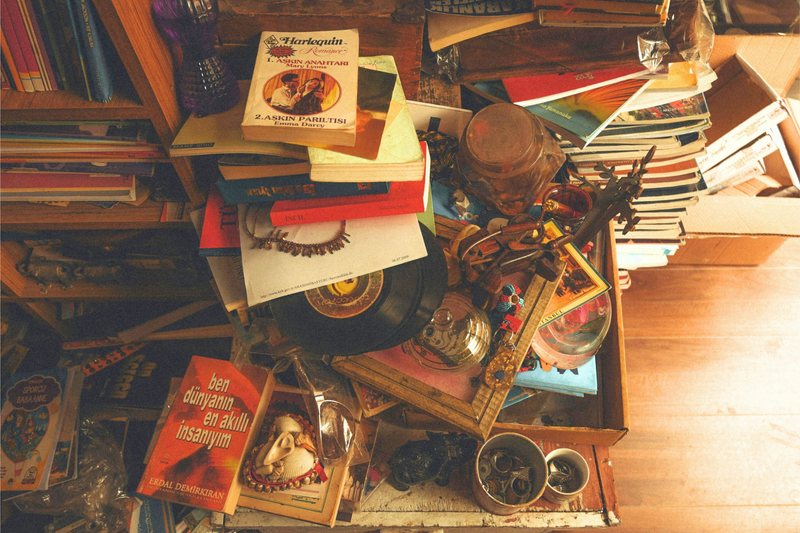Declutter Your Space, Declutter Your Mind: Effective Strategies to Reduce Stress
Effective strategies to reduce stress needs Understanding Stress and Its Connection to Clutter. Stress is a ubiquitous aspect of modern life, characterized by a state of mental or emotional strain resulting from adverse or demanding circumstances. This psychological response can manifest physically, leading to a variety of health issues, including anxiety, depression, and even chronic conditions such as cardiovascular diseases. The relationship between stress and environmental factors, particularly clutter, is significant and warrants careful examination.

Clutter refers to an accumulation of items that are disorganized or unwanted within a living or working space. Research has shown that clutter can serve as a constant reminder of tasks unfinished, thereby contributing to a state of overwhelm. When individuals are surrounded by chaos, it becomes increasingly difficult to focus their attention or feel relaxed. The presence of excessive items can lead to increased levels of frustration and anxiety, often leaving individuals feeling trapped in their surroundings.
The psychological implications of clutter extend beyond mere inconvenience. For many, a cluttered environment can disrupt their ability to think clearly and make decisions efficiently. This disarray can lead to the mental fatigue associated with trying to navigate and manage a chaotic space. Moreover, the sheer volume of items can invoke feelings of guilt and shame, aggravating one’s stress levels further. As a result, understanding the causal relationship between stress and clutter becomes essential for those seeking to improve their mental well-being.
Effective decluttering not only leads to a more organized space but can also significantly reduce stress levels. By creating a serene environment, individuals may find it easier to unwind, focus, and feel a sense of achievement. Thus, recognizing the impact clutter has on mental health is crucial in one’s journey toward stress reduction and overall well-being.
The Benefits of Decluttering for Stress Relief
Decluttering offers a multitude of benefits that significantly contribute to stress relief, providing both psychological and environmental advantages. A tidy environment fosters a sense of calmness that can mitigate feelings of anxiety and overwhelm. When one is surrounded by orderliness, it becomes easier to focus on tasks at hand, thereby boosting concentration. The clutter reduction allows the mind to process information more effectively, leading to improved cognitive function and enhanced productivity.
Moreover, a well-organized space has been associated with greater emotional well-being. Research indicates that individuals who maintain a clutter-free environment are less likely to experience stress-related symptoms. This positive correlation can be attributed to the fact that chaos in one’s surroundings often mirrors the chaos in one’s thoughts. By confronting and managing the physical disarray, an individual can begin to address internal disarray, making way for clearer thinking. Thus, decluttering serves not only to create an aesthetically pleasing space but also to foster mental clarity.
In addition, the act of decluttering itself can be therapeutic. Engaging in the process allows individuals an opportunity for self-reflection and decision-making, encouraging a proactive approach to stress management. This active participation places individuals in control of their environment, enabling them to create a space that aligns with their values and needs. Such alignment between one’s physical space and mental state can significantly enhance feelings of contentment and satisfaction.
Overall, decluttering emerges as a practical strategy for stress relief, empowering individuals to transform their surroundings and, ultimately, their mental landscape. By embracing a minimalistic approach and shedding unnecessary items, one can cultivate a serene and productive atmosphere, ultimately nurturing overall mental health and well-being.
Identifying Clutter: What to Let Go Of
Clutter can manifest in various forms, impacting both physical spaces and mental well-being. To effectively declutter, one must first identify what constitutes clutter in their lives. This involves a thoughtful evaluation of possessions, habits, and even relationships. A good starting point is to consider the frequency of use and the emotional value of items. If an object has not been used within the past year and does not evoke positive memories or feelings, it may be time to let it go.
Physical clutter—comprising items such as clothing, outdated electronics, or unused furniture—can be assessed through a “one-year rule.” This rule suggests that if you have not needed or used an item within the last twelve months, it may be more beneficial to part with it. Additionally, it is wise to evaluate items that causes stress. An overflowing closet or a chaotic workspace can contribute to feelings of overwhelm. Recognizing those items that do not serve a purpose can pave the way for a more harmonious living environment.
Mental clutter, on the other hand, often includes overwhelming thoughts, negative emotions, or stressful schedules. Take time to reflect on what thoughts or responsibilities weigh heavily on your mind. Journaling can be a useful tool to clarify thoughts and prioritize tasks; this allows you to recognize patterns that lead to mental clutter. Furthermore, be aware of relationships that drain your energy without providing support. By assessing which aspects of your mental landscape contribute to stress, you can actively work towards minimizing this clutter.
Ultimately, the process of identifying clutter necessitates a conscious effort to distinguish between what enriches your life and what hinders your peace of mind. Evaluating both physical and mental clutter offers clarity and paves the way for a more organized, stress-free existence.
Inside the Decluttering Process: Step-by-Step Guide
Embarking on a decluttering journey requires a structured approach to ensure effectiveness and sustainability. The first step in the decluttering process is to create a clear plan. Begin by setting a specific timeline and defining your goals. Determine what areas of your space need the most attention, such as bedrooms, living rooms, or home offices. By outlining a detailed plan, you can prevent feelings of overwhelm as you progress through the journey of decluttering.
Once you have an organized plan, focus on prioritizing the areas you want to tackle first. It is often beneficial to start with smaller spaces, such as a closet or a drawer, where you can envision immediate results. Successfully completing these smaller tasks can boost your motivation and make the entire decluttering experience more enjoyable. If possible, use this opportunity to involve family members, as a collaborative effort can foster a sense of community while simplifying the decluttering process.
Utilizing targeted techniques can further enhance your decluttering efforts. One popular method is the ‘one in, one out’ rule. This principle encourages you to let go of an item whenever a new one is introduced into your space, helping to maintain a minimalistic environment. Another effective strategy is the four-box method: designate four boxes labeled as keep, donate, trash, and storage. As you sort through your belongings, this categorization becomes a valuable tool to make informed decisions about what to retain and what to relinquish. Each box serves a distinct purpose, allowing for an organized and thoughtful decluttering experience.
In conclusion, approaching decluttering with a clear plan, prioritizing tasks, and employing effective techniques can significantly streamline the process. This structured method not only aids in achieving a tidier space but also contributes to a clearer mind, reducing stress and enhancing overall well-being.
Organizational Strategies to Maintain a Clutter-Free Environment
Creating and sustaining a clutter-free environment is essential for fostering a sense of calm and focus. Implementing effective organizational strategies can significantly contribute to this goal, promoting not only physical order but also mental clarity. One primary strategy is to utilize efficient storage solutions that maximize space while keeping essentials accessible. Consider investing in shelving units, bins, and drawer organizers that cater to your specific needs. Vertical storage options can be particularly advantageous in smaller areas, allowing you to utilize wall space effectively while minimizing the footprint of your belongings.
Establishing a routine for regular tidying is another key organizational strategy. Scheduling dedicated time each day or week for decluttering and cleaning can cultivate a habit of maintaining order. This routine could involve simple tasks, such as sorting through mail as it comes in or setting aside a few minutes daily to tackle a specific area of your home or office. Such consistent efforts can prevent accumulation and create an environment that feels more spacious and manageable.
In addition to physical organizational strategies, leveraging digital tools can further enhance your efforts to maintain a clutter-free environment. Utilizing apps for task management, note-taking, or file organization allows for easier access to important information while reducing the number of physical documents you keep. Consider organizing digital files with clear folder structures and tagging systems to streamline your workflow. Integrating both physical and digital organization techniques can lead to a significant improvement in productivity and overall well-being.
By adopting these organizational strategies, individuals can foster a more serene environment that supports mental clarity and reduces stress. The consistent application of effective storage solutions, regular tidying routines, and digital organization tools will contribute significantly to achieving and maintaining a clutter-free lifestyle.
The Role of Mindfulness in Reducing Stress Through Decluttering
Mindfulness, defined as the practice of being fully present and engaged in the moment, plays a pivotal role in the decluttering process. By incorporating mindfulness into decluttering tasks, individuals can significantly enhance their emotional well-being, reduce stress, and confront their attachments to objects in a more constructive manner. When aiming to declutter, many people may feel overwhelmed by the sheer volume of items they possess. This is where mindfulness can transform the experience from a burden into a reflective journey.
One of the fundamental aspects of mindfulness is awareness. While decluttering, practicing awareness allows individuals to recognize not only the physical objects in their space but also the emotions and memories associated with them. Each item often comes with its own story, representing moments of joy, nostalgia, or even regret. Without mindfulness, it may be easy to become lost in these emotions, leading to indecision about what to keep or discard. However, by approaching the decluttering process mindfully, one can acknowledge these feelings without being controlled by them. This balanced acknowledgment is crucial in reducing anxiety during the decluttering journey.
Moreover, mindfulness fosters a sense of intentionality in life’s choices, enabling individuals to focus on what truly matters in their environments. As one becomes more present, the decision-making process regarding which items to keep becomes clearer. By reflecting on each possession and its relevance to one’s current life, individuals can better understand their attachments and make decisions that transcend mere sentimental value. Consequently, this approach not only leads to a more organized physical space but also supports mental clarity and reduces stress.
In integrating mindfulness into decluttering, individuals are more equipped to confront their past while shaping their present and future in a healthier way. This holistic engagement ultimately fosters an environment conducive to peace and stress reduction, reinforcing the connection between a decluttered space and a decluttered mind.
Creating a Stress-Free Space: Decor and Ambiance Tips
Establishing a calming atmosphere within your home or workspace can significantly contribute to reducing stress levels. One of the most effective strategies for creating a stress-free space is to carefully select your color palette. Soft, muted tones such as blues, greens, and pastels can evoke tranquility and relaxation. Conversely, bright and bold colors may stimulate feelings of excitement or anxiety. Therefore, incorporating serene hues into your decor fosters a peaceful environment conducive to mental clarity.
In addition to color, the inclusion of natural elements is paramount in enhancing your space’s ambiance. Integrating plants not only purifies the air but also brings a sense of nature indoors. Foliage like peace lilies or snake plants can thrive in various environments and are relatively low-maintenance. The presence of greenery can reduce stress and create a refreshing aura, further promoting a decluttered mindset.
Lighting plays a crucial role in shaping the overall atmosphere of a space. Natural light is particularly beneficial, as exposure to sunlight helps regulate mood and energy levels. When possible, opt for sheer curtains that allow ample daylight to filter through. In the absence of natural light, consider using soft, warm lighting fixtures that mimic the gentleness of the sun. Dimmer switches can also be a valuable addition, facilitating the adjustment of light intensity based on the time of day and desired ambiance.
The impact of scent on mood is well-documented; therefore, utilizing aromatherapy can further contribute to a stress-free space. Essential oils such as lavender, chamomile, and eucalyptus are known for their calming properties. Diffusers or candles infused with these scents can enhance your environment, making it feel inviting and soothing. By integrating color, nature, light, and scent into your decor strategically, you can create a harmonious atmosphere that not only complements a decluttered space but also nurtures a tranquil mind.
Real-Life Decluttering Success Stories and Tips
Many individuals have found that decluttering their physical spaces has led to profound changes in their mental well-being. One such example is Sarah, a busy professional and mother of two. Overwhelmed by the chaos of her family’s clutter, she recounted how it contributed to her daily stress. After stumbling upon a decluttering method, she decided to take action. Sarah started small by dedicating just fifteen minutes a day to declutter a specific area, such as a drawer or a countertop. This gradual approach made the task feel less daunting, and over a few months, she managed to transform her home into a more organized space that fostered tranquility.
Another inspiring story comes from Tom, a college student who struggled with anxiety. His cluttered room was not just a physical representation of chaos but also a contributor to his mental stress. Motivated by the benefits of minimalism, he spent a weekend tackling his belongings. Tom focused on the “one in, one out” principle, where he would only keep items that truly brought him joy. As he sorted through clothes, books, and miscellaneous items, he discovered several pieces to donate. This not only cleared his space but also gave him a sense of purpose through helping others.
From these experiences, some practical strategies emerge for anyone looking to declutter: First, start with a specific area to keep the process manageable. Second, consider the psychological impact of each item, asking whether it adds value to your life. Lastly, incorporate a routine that maintains your space; even a few minutes each week can prevent overwhelming clutter from accumulating again. By applying these tips and learning from successful individuals, anyone can embark on their decluttering journey, ultimately leading to a more serene living environment and a clearer state of mind.
Sustaining Your Decluttered Space: Building Positive Habits
Maintaining a decluttered environment is a continuous process that requires the cultivation of positive habits and routines. To prevent the re-emergence of clutter, it is crucial to establish consistent practices that enhance your living space and mental well-being. One effective strategy is to perform regular assessments of your surroundings. This entails periodically evaluating each area of your home to identify any items that may have accumulated over time. Schedule specific times, whether weekly or monthly, to review your space and eliminate unnecessary clutter that may have built up.
In addition to regular assessments, it is vital to integrate small daily habits that promote a clutter-free space. Implementing a “one in, one out” rule can be particularly effective; for every new item acquired, an old item should be removed. This principle not only helps to manage the number of possessions in your home but also encourages mindfulness regarding your purchases. Furthermore, developing a habit of putting items back in their designated places immediately after use can significantly reduce disorganization. This practice requires discipline but can greatly simplify your daily routines.
Creating organizational systems tailored to your needs also plays a pivotal role in sustaining a decluttered environment. Storage solutions, such as shelving units, bins, and labels, can enhance efficiency and accessibility in your spaces, making it easier to maintain order. Additionally, consider setting aside time for decluttering practices, such as dedicating a few minutes each day or a couple of hours on weekends to organize different areas. By making room for these activities in your schedule, you prioritize a clean environment and reinforce the habits necessary for long-term sustainability.
Ultimately, the key to sustaining a decluttered space lies in your commitment to foster a lifestyle that values simplicity and mindfulness. Through regular assessments, establishing positive routines, and cultivating effective organizational systems, you can maintain a peaceful and serene background that supports mental clarity and reduces stress.




Post Comment